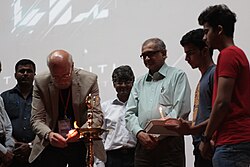Blog Credit: Trupti Thakur
Image Courtesy: Google
NASA’s ACS 3
On April 24, 2024, NASA has launched the Advanced Composite Solar Sail System (ACS3), marking an important moment in the utilization of solar power for space propulsion. A solar-powered spacecraft was deployed aboard Rocket Lab’s Electron rocket from New Zealand. This spacecraft, powered by sunlight, aims to test the efficacy and potential of solar sails in space transportation.
Understanding Solar Sail Technology
Solar sail technology harnesses the momentum of photons emitted by the sun, using large, reflective surfaces to propel spacecraft without traditional fuel. This technology leverages the constant outward pressure exerted by sunlight, similar to how wind sails capture the wind to propel sailboats. The Advanced Composite Solar Sail System spacecraft, approximately 80 square meters in size post-deployment, utilizes this innovative propulsion mechanism.
Design and Mechanism
The mission’s core component is an oven-sized CubeSat, which, after being lifted into orbit, deploys a solar sail. The spacecraft performs a series of manoeuvres to adjust its orbit using only the pressure of sunlight. The versatility of solar sail technology offers significant advantages for future space missions, potentially enabling manoeuvres and adjustments without relying on conventional fuel sources.
Implications for Space Exploration
The success of NASA’s solar sail mission could revolutionize space travel. Traditional spacecraft rely heavily on chemical propulsion systems, which require significant amounts of fuel. This dependency limits the scope and duration of missions due to the weight and volume constraints imposed by the fuel. In contrast, solar sails offer a lightweight alternative that could facilitate longer and potentially interstellar missions leveraging the unlimited solar energy.
Advantages Over Traditional Systems
The use of solar sails could dramatically reduce the cost and complexity of space missions. By eliminating the need for fuel, spacecraft can be lighter and possibly larger, only constrained by the size of the solar sails they can deploy. Furthermore, the ability to manoeuvre a spacecraft over indefinitely long periods using sunlight could open up new possibilities in the exploration of more distant astronomical objects.
Challenges and Future Prospects
While solar sail technology presents numerous opportunities, it also faces specific challenges, particularly concerning the size and durability of the sails and the precision required in spacecraft orientation and control. Ongoing advancements and the results from NASA’s solar sail mission will address these challenges, refining the technology for future applications.
Highlights
- NASA’s Advanced Composite Solar Sail System, or ACS3, is a solar sail spacecraft launched into Earth orbit on April 23, 2024.
- Solar sails harness the gentle push of sunlight for spacecraft propulsion.
- ACS will test sail boom materials that could enable much larger solar sails.
What is ACS3?
NASA’s Advanced Composite Solar Sail System, or ACS3, is a solar sail mission that will test out new sail boom materials in Earth orbit. Launched on April 23, 2024 aboard Rocket Lab’s Electron, ACS3 will deploy a sail about the size of a small apartment from a toaster oven-size spacecraft.
Solar sails harness the power of sunlight for spacecraft propulsion. Space missions like The Planetary Society’s LightSail 2 spacecraft have demonstrated that small spacecraft can use solar sails to change their orbits, expanding their possible uses.
Future solar sail missions will need bigger sails and lighter materials to maximize their performance. ACS3 will use lightweight carbon fiber sail booms instead of traditional metal booms. This will be the first test of this technology in space, and success will pave the way for future missions to use even larger sails.
What is solar sailing?
Light is made up of particles called photons. Photons don’t have mass, but they have momentum. As sunlight reflects off a shiny solar sail, some of its momentum gets transferred, giving the sail a small push. This push is slight but continuous, and over time can impart more thrust to a spacecraft than traditional chemical rockets.
Solar sails can reach unique destinations that are difficult or impossible to access with other propulsion systems. They may also be our best option for interstellar travel.
How will ACS3 advance solar sailing?
The acceleration a solar sail spacecraft receives from sunlight depends on the size of the sail and the mass of the spacecraft. To increase performance, mission designers must look towards bigger sails and lighter spacecraft.
Solar sails require long booms to hold them taut. LightSail 2 and other solar sail spacecraft use metal booms, which are heavy and can warp unpredictably due to the hot-and-cold temperature swings they experience in space. ACS3 will use composite booms made of carbon fiber reinforced polymer. CFRP materials have high strength and low weight, and can be found in numerous aerospace, automotive, and medical applications.
Each ACS3 sail boom measures 7 meters (23 feet) long, but weighs just 900 grams, or 2 pounds, making them 75% lighter than metallic booms. NASA says they are 100 times less susceptible to warping under extreme temperature swings.
The CFRP booms are strong enough to hold the sail tight, yet flexible enough to wrap neatly around a central spindle for launch. NASA is also investigating the use of CFRP materials to build human habitats on the Moon or Mars. If ACS3 is successful, NASA says composite sail booms could be used for follow-on missions with sails as large as 2,000 square meters (21,500 square feet).
How ACS3 works
At its core, ACS3 is a CubeSat — a small satellite built to standardized dimensions. LightSail 1 and 2 were 3-unit CubeSats about the size of a loaf of bread. ACS3 is a 12-unit CubeSat about four times larger than LightSail.
The composite sail booms deploy from tape measure-like central spindles, just like LightSail. The booms pull out four triangular sails to form a kite shape when fully deployed, measuring 9 meters (30 feet) per side. With a cutout for the center core, the total sail area is about 80 square meters (860 square feet).
ACS3 launched into Earth orbit via Rocket Lab’s Electron. Once ACS3 successfully deploys its solar sail, the spacecraft will attempt a series of orbital changes to demonstrate its capabilities.
Blog By: Trupti Thakur

25
AprNASA’s ACS 3
Apr 25, 2024Recent Blog
The TechKritiApr 26, 2025
India’s First Quantum Computing VillageApr 24, 2025
India’s Achievement In QKDApr 22, 2025
The V2G TechnologyApr 21, 2025
Country’s Specific Domain By GoogleApr 19, 2025




